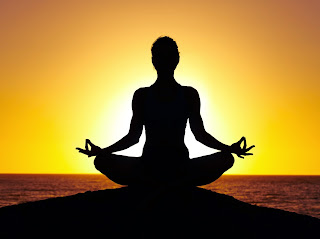What is Yoga?
The word yoga, from the Sanskrit word yuj means to yoke. It means "union" or a method of discipline. Yoga combines 8 different limbs: the Yamas (restraints), Niyamas (observances), Asana (postures), Pranayama (breathing), Pratyahara (withdrawal of senses), Dharana (concentration), Dhyani (meditation) and Samadhi (absorption). This then precedes to Samadhi (liberation, enlightenment).
Yoga is for everyone
Yoga is
available to all generations and fitness levels. It is tailored to your
lifestyle and ranges from hot yoga to power yoga to relaxation yoga and
prenatal yoga. If you are a beginner, Hatha yoga would be great for you. It
focuses on basic postures at a comfortable pace. If you want to increase
strength through using more of your own body’s resistance, power yoga may be
right for you. If you are ready for a deeper practice, Advanced Yoga, or
Bikram, also called “hot yoga,” may be just what you are looking for. In Bikram
yoga, the room temperature is set to around 100 degrees Fahrenheit, resulting
in greater elimination of toxins from the body through the increased production
of sweat. No matter your fitness level, fat percentage, or health history, yoga
has a place for you.
Yoga for Flexibility
Yoga poses work
by stretching your muscles which helps you move better and feel less stiff or
tired. At any level of yoga, you'll probably start to notice benefits soon. In
one study, people improved their flexibility by up to 35% after only 8 weeks of
yoga.
Strike a Pose for Strength
Practicing
Ashtanga and Power Yoga is very physical but will help you improve muscle tone.
Since the poses involve five full breaths, it is more focused and entails
deeper concentration. Breathing, posing, moving and increasing flexibility
happen altogether which solicits a new level of discipline in your mind and
body. But even less vigorous styles of yoga, such as Iyengar or Hatha, can provide
strength and endurance benefits. Such poses are downward dog, upward dog, the
plank pose and build upper-body strength. The standing poses, especially if you
hold them for several long breaths, build strength in your hamstrings,
quadriceps, and abs. Poses that strengthen the lower back include upward dog
and the chair pose. All poses can build core strength in the deep abdominal
muscles.
Better Posture from Yoga
When you're
stronger and more flexible, your posture improves. Most standing and sitting
poses develop core strength, since you need your core muscles to support and
maintain each pose. With a stronger core, you're more likely to sit and stand
"tall." Yoga also helps your body awareness. That helps you notice
more quickly if you're slouching or slumping, so you can adjust your posture.
Breathing Benefits
Yoga usually
involves paying attention to your breath, which can help you relax. It may also
call for specific breathing techniques. However, yoga typically isn't aerobic,
like running or cycling, unless it's an intense type of yoga or you're doing it
in a heated room. Another one of the benefits of yoga is that stretching and
holding of postures also causes muscles to lengthen, which gives the body a
longer, leaner look.
Less Stress, More Calm
Yoga helps
relieve stress, unclutter the mind and helps you get more focused. Some yoga
styles use meditation techniques that help calm the mind. Focusing on your
breathing during yoga can do that, too.
Good for Your Heart
Yoga has long
been known to lower blood pressure and slow the heart rate. A slower heart rate
can benefit people with high blood pressure or heart disease and people who've
had a stroke. Yoga has also been linked to lower cholesterol and triglyceride
levels and better immune system function.
Good for your Bowels
The digestive
system gets back on track when the stretching in yoga is coupled with a
healthy, organic diet, which can relieve constipation, irritable bowel syndrome
(IBS) and acid reflux.
There are
various paths of Yoga that lead toward a comprehensive system. They are:
Hatha Yoga — a system of physical
postures, or Asanas, whose higher purpose is to purify the body, giving one
awareness and control over its internal states and rendering it fit for
meditation.
Karma Yoga — selfless service to others
as part of one's larger Self, without attachment to the results and the
performance of all actions with the consciousness of God as the Doer.
Mantra Yoga — centering the
consciousness within through Japa or the repetition of certain universal
root-word sounds representing a particular aspect of Spirit.
Bhakti Yoga — all-surrendering devotion
through which one strives to see and love the divinity in every creature and in
everything, thus maintaining an unceasing worship.
Jnana (Gyana) Yoga — the path of wisdom
which emphasizes the application of discriminative intelligence to achieve
spiritual liberation.
Raja Yoga — the royal or highest path
of Yoga, immortalized by Bhagavan Krishna in the Bhagavad Gita and formally
systematized in the second century B.C. by the Indian sage Patanjali, which
combines the essence of all the other paths.
Now lay out your mat,
load this video on your smart device and try out this Morning weight loss yoga exercise!!!




Not a salmon person but the salmon dish was actually pretty good. Added carrots and cauliflower to spice things up a bit!
ReplyDeletevery good and ancient exercise
ReplyDeleteThanks for commenting. Yoga is a great method for reducing stress as one of it's many benefits. Try Yoga today.
ReplyDeleteHey I downloaded these yoga exercise videos to my smart phone. I love doing yoga. Usually I look for different online yoga workouts and downloaded them to learn new yoga techniques.
ReplyDelete